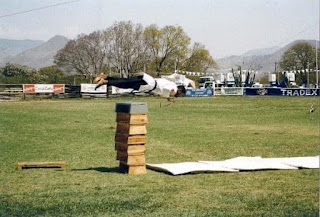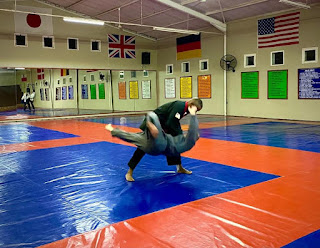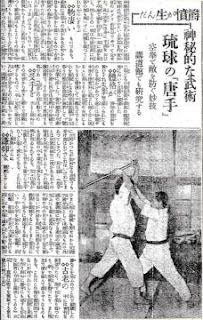 |
| Sensei Funakoshi performing the kata “Sōchin”, one of the kata I learnt from him. |
Funakoshi Okinawan Karate Kenpo Kenkyukai
The Funakoshi Okinawan Karate Kenpo Kenkyukai (Research Society & Study Group) is dedicated to studying and researching, in particular, Master Gichin Funakoshi's Okinawan Shorin-ryu karate kenpo teachings. For authoritativeness, Master Gichin Funakoshi's old Okinawan karate, his later developed karate, Master Gigo Funakoshi's karate, the developments of Shoto-kai, & every other karate kenpo lineage, are all considered.
Saturday, 13 July 2024
Sensei Kenneth Yoshinobu Funakoshi Passes Away
Saturday, 5 August 2023
The Art and Skill of Real Fighting
In a real fight, which is a matter of life-or-death, you need to be very quick. In particular, your hands need to be sharp, instantly acting and reacting. You cannot delay or hesitate; you have to be decisive and confident, although not over-confident or egotistic. You cannot afford to be negligent in your training each day. You have to diligently focus yourself every single day, training earnestly whenever possible, forging your mind, body, and spirit [of character and the essence of life at one with the Universe and the Creator of everything, given various terms depending on the culture or belief system, the Christian term, in English, being “God”]. In fact, on the topic of the training of the “spirit” in the fighting arts, religion and philosophy are so often seen intertwined in so many schools, traditionally not separating fighting, but instead even going so far as to include an element of worship. Of course, these days, I certainly wouldn’t discuss beliefs in any specific way in classes, as they are personal and every person should be respected for who they are and what they believe.
Certainly, forms on their own are no good. They have plenty of practical purposes, but actual fighting skills require more than just the artistic methods of practising fighting techniques individually. To be able to actually fight, you have to develop the skills of using both hands together, applying leg and arm techniques simultaneously, utilising multiple techniques and multiple levels for attacks, and not only recognising the importance of speed in actual conflict, but understanding how to properly apply both yin and yang in accordance with your opponent/s, as well as being agile and flexible to enable swift movement in any direction without delay, avoiding even being so much as touched by your attacker’s fist or, indeed, weapon, measuring distance and having perfect timing, waiting until the last moment, and always, even if sometimes shifting back, advancing towards the enemy strategically, employing clever tactics based on the principles of actual fighting. This is real authentic karate / karati – Okinawan Shaolin boxing.
Monday, 31 July 2023
Chōji-dachi, Fudō-dachi, and Naihanchi-dachi: Ideal Postures for all Directions
There are many different stances and postures in karate. Often in old karate, some version of T-stance (chōji-dachi) was used. Obviously that means it has genuine benefits for actual fighting, as opposed to always standing in some form of front stance when fighting, ready to move forwards or back, left or right, up or down. You can shift between zenkutsu-dachi, kokutsu-dachi, and naihanchi-dachi seemlessly with minimal movement, simply turning on the heels, in the old way that Gichin Funakoshi practised. Particularly from an open chōji-dachi, you can easily defend in multiple directions. However, you can use your hips better in a regular front stance, when attacking with the rear fist aiming forwards. But what about to the open side, for instance? Therefore, an angled naihanchi-dachi is better for mutiple directions with minimal movement. This is like fudō-dachi, but high, so, because a low stance is useful at times, shifting between naihanchi-dachi and fudō-dachi is certainly advantageous, although always only in accordance. In actual fighting, it’s ideal to use minimal movement to change direction, apply maximum power using the body’s mechanics, shift your weight as necessary between yin and yang, be heavy, light, or strategically one then the other, depending, and move dynamically very actively when necessary, suddenly shifting the entire body swiftly, and always not allowing your opponent/s to so much as touch you with their attacks. All of the classical stances are useful, including the version of chōji-dachi in which the heels are in line. However, as with Gichin Funakoshi, you shouldn’t stick to one stance or kind of stance. Moving in accordance, every posture is valuable. But I feel that the different types of chōji-dachi, fudō-dachi, and naihanchi-dachi (the “horse” stance) are particularly applicable.
Wednesday, 7 June 2023
What is Funakoshi karate?
The Funakoshi Okinawan Karate Kenpō Kenkyūkai is a research and study group dedicated to Funakoshi karate. However, to be truly authentic in approach, there is no segregation, in reality. All karate lineages are considered, along with other styles, whether related to old-style karate or not. My school, Matsuyoshi-juku Shōtō-ha Shōrin-ryū Karate Kenpō to Kobujutsu, is, likewise, dedicated to Funakoshi karate. But, again, that doesn’t mean that it is only concerned with what has been compiled in the past as the content of this or that Funakoshi karate lineage. Indeed, it is evident that the various Funakoshi karate lines teach different things to one another. It isn’t a matter of them all teaching the same content. This is even true amongst the same general type of Funakoshi karate, such as Shōtōkai, in which we can see one line teaching 15, or so, kata, and another teaching many more. The point here is that it isn’t true to say that Funakoshi karate comprises this and that kata, as such. Of course, it can’t be Funakoshi karate without teaching what Gichin Funakoshi and / or Gigō Funakoshi taught. But any school can include additions and variations. That’s exactly the situation that exists. You could even select a handful of kata and only practise and teach those, and it would still be legitimately Funakoshi karate.
S. R. Marshall
Thursday, 20 April 2023
Koryu Kata: Effective Methods from Actual Fighting
The old forms like kūsankū, gojūshiho, sēsan, jitte, and many more, were developed through actual fighting, often in matches, but also in street situations in various cases, and they are ultimately related to the ancient Chinese military. In the same way, techniques in karate like those found in tuidi, are from actual fighting and are derived from the ancient Japanese military and Okinawan grappling called tigumi. Although we don’t practise in a militaristic way in my school, discipline is a quality of the military, and our methods are related to the military. This is why it is important to preserve the old ways; not for the sake of it, but because they were developed from war, hardship, and actual fighting in matches and in the street. That makes the techniques and methods genuinely useful, as opposed to many, though not all, modern ideas that are often either not based on actual fighting, or are based on competitive and prize matches, meaning that they have removed the element of the real danger of losing your life. Without that, the techniques may be good to a point, but they will lack what is required to fight effectively in a life-or-death street-fight that happens at random, as they do. Just like the old days, people with military experience who have fought in war are good modern examples of people with actual fighting experience, as well as those who have had to defend themselves in the street.
Many people with martial arts schools these days have experience of fighting in competitions, and know how to win with strategy and tactics. These teachings can be useful, still, for the street, but, again, I would argue that it’s dangerous to rely on techniques not aimed at life-or-death conflict. Actual fighting is different and requires something more. People such as police officers would appreciate this point. When I was a teenager, I competed for a couple of years before realising that, for me, there was no point in fighting for trophies. The only other competition I entered after the age of 17 was when I was 20, and it was aimed at being more of a demonstration for the school I was a member of, and assistant instructor with, at the time. Following this, I left that side of martial arts behind, for good, although not forgetting the tactics I had been taught.
For my school, Matsuyoshi-juku Shōtō-ha Shōrin-ryū Karate Kenpō to Kobujutsu, my real fighting experience is from actual situations. The reason I want to share this is because I feel that it is necessary for a martial arts teacher to understand actual fighting, and therefore to be able to provide support for why they have their own school in which there teach, as the basis, fighting. From the age of 18, aside from a couple of incidents in which I was attacked during high school, first when I was 11, and then at 15 years old, I have experienced many different situations, against individuals and multiple opponents. I’ve had to defend, grapple, avoid being tripped, strategically escape, purposefully reposition the direction of the Sun, simply stand ready to react if necessary, release from a grip and create distance, and more. What I’ve learnt from these experiences, coupled with having studied strategy and tactics, is not limited to proving certain techniques from kata such as naihanchi and kūsankū to be evidently useful, but is, additionally and generally, that distance and timing are critical, along with speed, accuracy, agility, a strong stance, the effective application of the principles of hard and soft, and, even in the street, strategy and tactics. People should always avoid fighting at all reasonable costs. Although, it cannot be denied that actual experience in anything always enables real learning and understanding. In all of the actual situations I’ve experienced so far in my adult life, I was the defender, and in all cases I avoided being hit, and, when actually making contact, I didn’t use excessive force, as I didn’t need to. You only need to apply the amount of force necessary, minimising to be efficient. Stamina is very important in actual fighting, and a key aspect of retaining stamina is to simply be efficient, although physical fitness and correctly regulated breathing are highly necessary as well. In my opinion, real martial arts, whether old-style or newer, should be mainly concerned with how to effectively defend in random situations of life-or-death. Hence, my philosophy in my school is to be mainly concerned with life-or-death situations, and how to effectively and efficiently defend yourself, also using strategy and tactics, as a last resort.
S. R. Marshall
Godan, Shōrin-ryū Karate
Sunday, 26 March 2023
What is Koryū?
Koryū is defined in Japanese martial arts as being anything created before the Meiji Restoration in 1868. After 1879, at the latest, including for the Ryūkyū Kingdom, new martial arts creations would be classed as gendai. However, that doesn’t mean that koryū disappeared. If someone learnt a method created before the Meiji Restoration, they were still studying koryū bujutsu. The reasons I would argue that the time period goes up to 1879 are that the Ryūkyū Kingdom became Okinawa Prefecture completely by 1879, and the rebellion in Japan against the new regime ended by that time, if we are to generalise to simplify. Therefore, a lot of what is practised in Funakoshi karate, for example, is koryū, even in the lineages with more changes from what Gichin Funakoshi himself taught, in my opinion. Although, the fewer the changes, the closer the versions are to the koryū kata and methods originally learnt by Funakoshi in Okinawa from just after the archipelago became part of / a prefecture of Japan.
Kata such as the Pin’an series and Meikyō are gendai, in that case, although they are based on koryū kata. Whereas kata and methods such as Kūsankū, Jion, Sēsan, Naihanchi, Jitte, Chintō, and many others are koryū, as they were created before the Meiji Restoration. However, I would also argue that it doesn’t matter too much as to if you practise koryū kata or gendai kata, so long as they are effective and based on actual fighting experience. That being said, the reason koryū methods are good, still, is because they were developed through actual fighting of all kinds, from battles to street-fights, and refined by many experts over centuries or longer. Therefore, it makes sense to keep these traditions alive.
S. R. Marshall
Wednesday, 8 February 2023
Funakoshi-ha Passai [Dai & Sho]
Gichin Funakoshi taught one passai, which he learnt from Anko Itosu, at least mainly, if not entirely, as others such as Kanken Toyama, Kenwa Mabun, and Chosin Chibana learnt a version of passai from Itosu that is basically the same, with some variations (wherever each of their differences actually came from…). Whether or not he did know other versions, he at least knew of others, such as the passai that is taught in several lines of Funakoshi karate, called passai [sho]. He was also at least aware of Tomari passai, as another of his teachers, Anko Asato, noted that it is a practical kata, during an interview between Funakoshi and Asato.
Passai [sho] was apparently also taught by Itosu, and is said to have been created by him. However, there are other passai that bear similarities. One is called koryu passai. Another name for it is Gusukuma passai. While there is yet another Gusukuma passai, which has various similarities, the former, otherwise known as koryu passai, suggests that it is an old passai. If that’s true, it may be that passai [sho], which is a variation of koryu passai, might be Itosu’s version of koryu passai.
The passai taught by Funakoshi is called passai [dai] when separating it. Based on comparison with other passai, it appears to be a combination of Ishimine passai and Tomari passai. Ishimine and Tawada learnt from Sokon Matsumura. There are similarities between Ishimine passai and Tawada passai, so we know from them which techniques are most likely from Matsumura. Nonetheless, Funakoshi-ha passai [dai] must be Itosu’s combination of Ishimine passai and Tomari passai, which I think is interesting.
S. R. Marshall
Saturday, 7 January 2023
The “Karate” Teachings of Anko Asato
Anko Asato, for example, learnt a range of martial arts, including Jigen-ryu kenjutsu, archery, horsemanship, various other weapons arts, and empty-handed fighting. He had more than one teacher, as he was apparently taught Jigen-ryu swordsmanship by the same teacher who instructed Sokon Matsumura. But Asato was taught ti by Sokon Matsumura and no one else. Anko Itosu learnt such kata as gojushiho from Matsumura, evidently, so Asato surely must have also learnt gojushiho.
There are two points that I want to make here. The first is that what we call “karate”, as if “karate” is really a martial art in itself, used to just be whatever martial arts a person learnt from wherever. Ti (te in Romanised-Japanese) means hands or skills. It’s just a reference to martial arts. If you learnt some Chinese boxing method from someone, in Okinawa or elsewhere, it would become part of your ti. If you learnt jujutsu in Japan, that would also become a part of your “Okinawan” martial arts. Karate/karati is a mixture of various methods and arts. Therefore, the same rule applies now. Of course, you wouldn’t call your martial arts “karate” unless you learn something that is called “karate”. But if you also study jujutsu, kenjutsu, Chinese boxing, or any other fighting method, depending on how you want to approach it, that might become a part of “your” karate, in the same way as the old masters.
The second point I want to make is just that if Asato probably learnt everything Matsumura had to teach, which included gojushiho, and apparently taught Gichin Funakoshi everything he knew, even saying that he would tell Funakoshi about anything he discovered concerning his later research into ground fighting, with the purpose of having Funakoshi teach Asato’s son, then Funakoshi must have been very trusted, close with Asato, and taught a lot more than he generally passed on to his students. Logically, you would think he had to have been taught such methods as gojushiho, if Asato was being so thorough. I wonder, in order to find evidence if it exists, if Asato’s son did learn everything from Funakoshi, and if he transmitted it to anyone, and if that lineage continues to this day. It doesn’t really matter if a person knows or teaches certain kata, as each kata is a system of techniques, and, as Asato and Kenwa Mabuni noted, you only need a few – between 2/3 and 5/6. And it’s true that you can’t specialise in more than this amount. Each system is so complex and difficult to master, so you need to focus your practice if you want to have any hope of becoming truly skilled and knowledgeable. But, as a matter of interest in clarifying what koryu karate was/is, I wonder if there is a school somewhere, perhaps in mainland-Japan or Okinawa, where the complete teachings of Master Asato can be found. And I wonder if that would include Jigen-ryu kenjutsu and other arts, or, indeed, if not everything was taught to Funakoshi, for whatever reason, or if he simply decided what he wanted to practise and teach, and excluded certain methods. Unfortunately, while I wonder these things based on logic, the evidence may not exist to prove anything more either way.
S. R. Marshall























![Yoshitaka Funakoshi jump, probably in kusanku [sho] (kanku [sho])](https://blogger.googleusercontent.com/img/b/R29vZ2xl/AVvXsEje1wGAB1ZkSCft3_g90N4C3yw31f_Wa24-OZk0Xd8IhdSL19qZ6mtzjN8sbiFU2oep84WxzjeaBgSybEnEyJvT_Xz6jNJvOEugXET2-NCgB5drCe0q1xDWYtff71jFmwReauBPXZe_tw06srpVm3ruWj4_Y_4jdFG3aEgirP12btmfFD7otrumaxg6/w320-h232/IMG_6909.jpeg)





